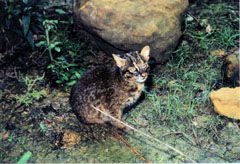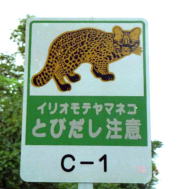After Surviving on Its Own for at Least Two-Million Years, a Rare Japanese Wildcat Is Facing Its Toughest Battle Yet

"Cats don't belong to people. They belong to places."
-- Wright Morris
On a remote Japanese island in the Pacific one of the world's rarest and most endangered cats is waging an heroic uphill struggle not to join the woolly mammoth and the dodo as just another historical curiosity.
Unknown to the outside world until its discovery by Japanese writer and naturalist Yukio Togawa in 1965, Prionailurus iriomotensis (or Felis iriomotensis) is found only on the subtropical island of Iriomoto, two-hundred kilometers east of Taiwan. (See map below.) The cat, which au premier coup d'oeil could be mistaken for Felis domesticus, is thought by most researchers to actually be a separate species that originated in China before the shima broke off from the mainland.
More astonishingly, the International Society for Endangered Cats has reported that fossils found on a neighboring island strongly suggest that the cat has existed as a separate species for more than two-million years. By way of comparison, Homo Sapiens have only been around for a mere one-hundred-fifty-thousand years.
Not everyone agrees with this analysis, however. For example, some researchers have suggested that the Iriomote wildcat is an offshoot of the leopard (Prionailurus bengalensis). Anatomical differences between the two cats, however, cast doubt on this hypothesis. For one thing, the Iriomote cat's claws are neither fully sheathed nor do they fully retract. Also, its toes are partially webbed.
The cats, which are approximately the same size as domestic felines, have dark-brown fur that is marked with dark spots that tend to merge into bands. (See photos above and below.) They have yellow eyes with white spots on the backs of their rounded ears. They divide their time between the mountainous tropical rainforest that comprises the interior of the two-hundred-eighty-two square kilometer shima and the sandy beaches along the exterior. Their interior habitat is legally protected but not the coastal areas.

Being primarily carnivores, their diet consists of fruit bats, wild pigs, rodents, box turtles, skinks, frogs, crabs, birds, and insects. In marked distinction to their domestic cousins, they do not have any aversion to the water and are not only excellent swimmers but adept at supplementing their diet with several varieties of fish including mudskipper.
They mate usually between December and March and again in September and October. These unions, however, only produce between one and four kittens. Although they have been known to leave their mothers at as early as three-months of age, the newborns do not reach sexual maturity until they are approaching their first birthday.
Although the cat has been legally protected since 1967, less then one-hundred of them are known to survive. Whereas some experts maintain that their population has remained stable for the past forty years, others feel that the species is actually in decline. Despite concerted efforts on the part of the Japanese government to save it, the cat is facing considerable obstacles.
As usual, the money men are the principal culprits in its decline. An estimated fifteen-hundred of the shima's twenty-two-hundred residents are engaged in ever-expanding sugar cane, pineapple, and rice growing operations as well as cattle ranching. Indigenous residents, who have long known of its existence, also hunt the yamaneko (mountain cat) for its flesh which they consider to be a delicacy. Seven-hundred-thousand tourists also visit the so-called "Galapagos of Asia" each year no doubt, in part, with the hope of getting a glimpse of the reclusive cat.
This flurry of activity has led not only to a reduction in the cat's habitat but the corresponding increase in vehicular traffic claims the lives of approximately ten of them each year. To their credit, the Japanese have built eighty cat underpasses along the shima's main two-lane highway in addition to erecting numerous cat crossing warning signs and information billboards. (See photos below.)

A twenty-four-hour hotline also has been set up in order to encourage motorists and others to report injured cats. Once a call is received, the cats are collected and transported to the Iriomote Wildlife Conservation Center where scientists such as Maki Okamura (See photo below) use specially installed video cameras in order to monitor their progress. Not having humans in sick bay all the time reduces stress on the cats and helps to hasten their recovery.
Not knowing when to put the brakes on both technology and their own ambitions, champions of the cat unfortunately have gotten on the surveillance bandwagon. For instance, remote cameras have been installed in the jungle in order to keep tabs on their comings and goings and some of them have been fitted with radio transmitters.
Although the conservationists strenuously argue that these measures are intended only to keep track of the number of cats that remain and to delineate their range, this is a subterfuge in order to allow them to make guinea pigs out of their subjects. Like all animals, the cats need protected habitats, not surveillance.
Even though the specifics of the tagging program are not known, it can nonetheless be safely assumed that all injured cats brought to the rehabilitation center have radio transmitters implanted under their skin. The researchers possibly could be fitting transmitters into collars but since they have a tendency to come off this is somewhat less likely although not totally out of the question.

In addition to being unnecessary and extremely stressful, trapping and tagging can sometimes be lethal. The scientific community and in particular the World Wildlife Fund should be compelled to reveal not only how many animals that they kill trapping and tagging but also how many later die from complications engendered by this mischief. It is therefore imperative that all tagging and snooping on the animals be outlawed. (See Cat Defender post of May 4, 2006 entitled "Scientific Community's Use of High-Tech Surveillance Is Aimed at Subjugating, Not Saving, the Animals.")
Other factors adversely affecting the cat's survival chances include interbreeding with domestic cats, which is reducing its available gene pool, and new diseases that are being introduced to the island by way of tourism and development. Crab traps and predators such as stray dogs are also having a deleterious impact.
"The wildcat's barely hanging on," Okamura confessed to the Environmental News Network on October 27th. (See "One of the World's Rarest Wildcats Tests Japan's Resolve to Save the Environment.") Nonetheless, "We still have time to save it," she optimistically added.
Japan's past record on both the animals and the environment is indeed a dismal one. A large number of both animals and birds have been either hunted to oblivion or had their habitats so ravaged by developers that they eventually became extinct. Most notably, the Japanese slaughter thousands of whales each autumn and winter in the Southern Ocean Sanctuary. (See Cat Defender post of January 27, 2006 entitled "Sea Shepherd and Greenpeace Run Out of Fuel Leaving Minke Whales to the Mercy of Japanese Harpooners.")

This year the Japanese intend to kill one-thousand-seventy minkes plus a cumulative total of one-hundred-seventy Brydes, seis, sperm, and fins. Before leaving for the Antarctic on November 15th, the Japanese whaling fleet slaughtered thirty-five whales off of Hokkaido. (See Environmental News Network, November 15, 2006, "Japanese Research Fleet Leaves for Annual Antarctic Hunt.")
The Japanese's barbaric treatment of marine mammals is not limited to whales. For instance, every year they herd up to twenty-one-thousand bottlenose dolphins into shallow coves and then eviscerate them with knives. These senseless killings serve no purpose other than to provide the Japanese with an opportunity to demonstrate their manhood and to thumb their noses at international opinion. (See Washington Post, November 20, 2006, "Intelligence of Dolphins Cited in Fight Against Hunt" and Environmental News Network, November 21, 2006, "Group Wants Japan to End Dolphin Hunting.")
Despite its shortcomings, the program to save the Iriomote wildcat is a welcomed about-face on the part of the Japanese. Also, the fact that the cat's image now adorns municipal buses, key chains, coffee mugs, and refrigerator magnets is a sign that animal rights issues are slowly creeping into the consciousness of the Japanese public.
Having been called a living fossil by some, the Iriomote wildcat is one of the animal kingdom's precious gems. To allow this very rare cat to disappear is unthinkable. It is therefore imperative that not only the Japanese but conservationists around the world take drastic steps to ensure its survival.

First of all, its protected habitat desperately needs to be expanded to include coastal areas as well as the jungle. Development must be drastically curtailed and severe restrictions need to be placed on the operation of motor vehicles. Since the cat is primarily nocturnal, vehicular traffic should be banned after dark.
Laws are also needed to curb the scientific community's curiosity and fascist tendencies. The cat will only survive if it is left alone in a protected habitat. As Wright Morris and other have often remarked, "Cats don't belong to people. They belong to places."
Photos: Web Japan (wildcat, map), Iriomote Ranger Office (wildcat), Kanpira (road signs), and Itsuo Inouye of the Associated Press (Maki Okamura).

<< Home